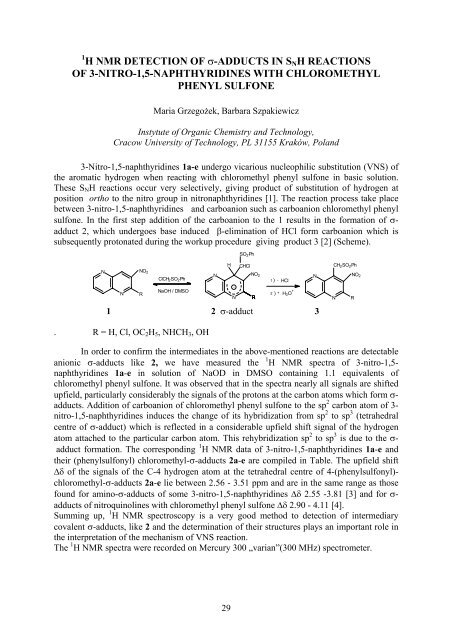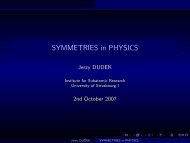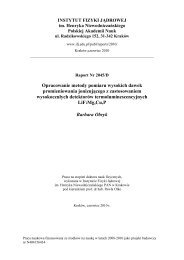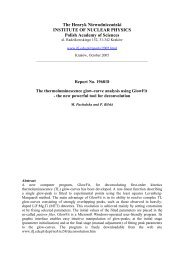Report No xxxx - Instytut Fizyki JÄ drowej PAN
Report No xxxx - Instytut Fizyki JÄ drowej PAN
Report No xxxx - Instytut Fizyki JÄ drowej PAN
You also want an ePaper? Increase the reach of your titles
YUMPU automatically turns print PDFs into web optimized ePapers that Google loves.
1 H NMR DETECTION OF σ-ADDUCTS IN S N H REACTIONS<br />
OF 3-NITRO-1,5-NAPHTHYRIDINES WITH CHLOROMETHYL<br />
PHENYL SULFONE<br />
Maria Grzegożek, Barbara Szpakiewicz<br />
<strong>Instytut</strong>e of Organic Chemistry and Technology,<br />
Cracow University of Technology, PL 31155 Kraków, Poland<br />
3-Nitro-1,5-naphthyridines 1a-e undergo vicarious nucleophilic substitution (VNS) of<br />
the aromatic hydrogen when reacting with chloromethyl phenyl sulfone in basic solution.<br />
These S N H reactions occur very selectively, giving product of substitution of hydrogen at<br />
position ortho to the nitro group in nitronaphthyridines [1]. The reaction process take place<br />
between 3-nitro-1,5-naphthyridines and carboanion such as carboanion chloromethyl phenyl<br />
sulfone. In the first step addition of the carboanion to the 1 results in the formation of σ-<br />
adduct 2, which undergoes base induced β-elimination of HCl form carboanion which is<br />
subsequently protonated during the workup procedure giving product 3 [2] (Scheme).<br />
N<br />
N<br />
SO 2 Ph<br />
H CHCl<br />
CH 2 SO 2 Ph<br />
NO 2<br />
N<br />
NO 2<br />
N<br />
NO 2<br />
ClCH 2 SO 2 Ph<br />
1 ) - HCl<br />
−<br />
NaOH / DMSO<br />
R<br />
2 ) + H 3 O +<br />
N R<br />
N R<br />
1 2 σ-adduct 3<br />
. R = H, Cl, OC 2 H 5 , NHCH 3 , OH<br />
In order to confirm the intermediates in the above-mentioned reactions are detectable<br />
anionic σ-adducts like 2, we have measured the 1 H NMR spectra of 3-nitro-1,5-<br />
naphthyridines 1a-e in solution of NaOD in DMSO containing 1.1 equivalents of<br />
chloromethyl phenyl sulfone. It was observed that in the spectra nearly all signals are shifted<br />
upfield, particularly considerably the signals of the protons at the carbon atoms which form σ-<br />
adducts. Addition of carboanion of chloromethyl phenyl sulfone to the sp 2 carbon atom of 3-<br />
nitro-1,5-naphthyridines induces the change of its hybridization from sp 2 to sp 3 (tetrahedral<br />
centre of σ-adduct) which is reflected in a considerable upfield shift signal of the hydrogen<br />
atom attached to the particular carbon atom. This rehybridization sp 2 to sp 3 is due to the σ-<br />
adduct formation. The corresponding 1 H NMR data of 3-nitro-1,5-naphthyridines 1a-e and<br />
their (phenylsulfonyl) chloromethyl-σ-adducts 2a-e are compiled in Table. The upfield shift<br />
∆δ of the signals of the C-4 hydrogen atom at the tetrahedral centre of 4-(phenylsulfonyl)-<br />
chloromethyl-σ-adducts 2a-e lie between 2.56 - 3.51 ppm and are in the same range as those<br />
found for amino-σ-adducts of some 3-nitro-1,5-naphthyridines ∆δ 2.55 -3.81 [3] and for σ-<br />
adducts of nitroquinolines with chloromethyl phenyl sulfone ∆δ 2.90 - 4.11 [4].<br />
Summing up, 1 H NMR spectroscopy is a very good method to detection of intermediary<br />
covalent σ-adducts, like 2 and the determination of their structures plays an important role in<br />
the interpretation of the mechanism of VNS reaction.<br />
The 1 H NMR spectra were recorded on Mercury 300 „varian”(300 MHz) spectrometer.<br />
29

















